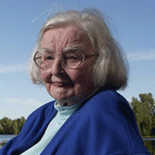
In 1997, the Kitchener-Waterloo Arts Awards presented Edna Staebler with its highest distinction: a Lifetime Achievement Award. She was honoured as a prolific writer of national and international stature and as the founder of two endowed programs designed to encourage writers just embarking on their own careers.
She was, at the time, a sprightly 91.
Still, her friends wondered if such an award wasn’t premature. They know Edna, after all. They have witnessed how her insatiable curiosity about people and places energizes her every waking moment. They have seen how that attentiveness animates her writing, motivates her generosity, and assures a steady stream of people to her home on Sunfish Lake—people who come and leave as friends. They knew Edna’s life time of achievement would continue vigourously to unfold.
In fact, it would be fairer to speak of 'lifetimes' of achievement for Edna Staebler, who will be honoured at the 16 Annual Mayors’ Dinner on April 5th.
The first began with her youthful determination to read all the books in the Kitchener Public Library 'beginning with the A`s. A degree from the University of Toronto, a stint as a teacher and another managing the family business, followed by marriage arid prominent positions of community leadership with the Library Board and the University Women’s Club would have qualified as a lifetime of achievement for many people.
But Edna harboured a secret de sire. She wanted to write. 'Those were the years when I wanted to be a writer, but I didn’t know what to write about. I thought I had to be a fiction writer, that I had to make it all up out of my head. But I just couldn’t seem to do that.'
Then, during a trip to Cape Breton Island and three weeks of living with the poor but resourceful inhabitants of Neil’s Harbour, she realized that she must write about the real people and places that transfixed her. 'When I met the fishermen and their families and lived with them, I thought, 'This is what I should write about.' And she did, with a clear, fresh voice respectful of the people she profiled and excited by the ways in which they lived their lives.
Still, one isn’t a Real Writer until one is published. So, in the spring of 1948, apparently unaware of the nice ties of manuscript submission, Edna travelled to the Macleans offices in Toronto and presented her first, unsolicited article to the editor, Scott Young. It was about a swordfishing expedition undertaken by three sceptical fishermen—whose Maritime dialect was faithfully rendered—and one plucky female landlubber: Edna.
The article was accepted for publication and the second of her lifetimes began.
It was a heady period. Canada was a country just beginning to take an interest in itself. Edna was befriended by a generation of writers—including WO. Mitchell and Pierre Berton—who were passionate about finding and telling Canadian stories. She became a regular contributor to the leading magazines and newspapers of the time, including Maclean’s, Saturday Night, The Toronto Star and Chatelaine.
But there was no glamour in the stories she wrote. Her articles documented her time living with a community of Hutterites in Alberta, the Iroquois of the Six Nations, the crew of a freighter from Quebec and a mining family in Wawa. It was full-immersion journalism.
Pierre Berton saw clearly that Edna was breaking down the boundary between writer and subject. “Edna immerses herself in her story... [S]he becomes part of the narrative. She lives .the lives of the people she writes about; she listens to their problems and they become her friends.”
In 1950, Chatelaine published an article entitled “How to Live Without Wars and Wedding Rings” about Edna’s experiences living with the Martins, an Old Order Mennonite family. It won the Canadian Women’s Press Club award. It also led to her friendship with Bevvy Martin and set the table for her most visible success: her series of chatty, informal cookbooks featuring traditional Waterloo County recipes. No less an authority than the Oxford English Dictionary credits Edna with bringing that lip-smacker of a word, ‘schmecks’, into common English usage.
Food that Really Schmecks was published in 1968 and became an instant and enduring success. Readers loved Edna’s folksy recipes for Mennonite staples like drepsley soup, schnippled bean salad and shoofly pie. Again, her personality—funny and unpretentious—shone through, as in this advice about perking up “tired car rots”: “Towards the end of winter when carrots are limp—and I am too—I sometimes give them a shot by sprinkling them with any of a variety of things in my herb cupboard.”
Edna had always befriended the people she wrote about. Now, she was befriended in turn by her readers. “There isn’t a week that goes by that I don’t get a letter even now, sometimes from exotic places like Saudi Arabia or Switzerland or Germany, telling me that Scmecks is their favourite cookbook and that they think of me as their friend.” Edna could easily be the poster person for late bloomers. Her first magazine article was published when she was 42. “And my first book wasn’t published until I was 60!” Her second lifetime hit full acceleration just at the point when most people retire.
1972 saw the publication of Cape Breton Harbour, a full account of her Neil’s Harbour experiences and her favourite work. More Food that Really Scmecks (1979) and the daringly titled Schmecks Appeal (1987) responded to an undiminished public appetite for schmecks, and a twelve- book Schmecks Appeal series was published in 1990-91.
The best of her magazine articles were published as Whatever Happened to Maggie? (1983) and Places I’ve Been and People I’ve Known (1990) and, in 1995, she published her correspondence with her sister in Haven’t Any News: Ruby’s Letters from the Fifties.
This sudden success—and a modest lifestyle—gave Edna the opportunity to embark upon her third lifetime of achievement. “It was so important to me to have won the Canadian Women’s Press Club award. It meant that I was a real writer at last. So I wanted to do something to help people just starting their writing careers in the same way the Press Club award encouraged me.”
Edna Staebler Award for Creative Non-Fiction
To that end, she worked with Wilfrid Laurier University to establish the Edna Staebler Award for Creative Non-Fiction in 1991. The award recognizes the first or second non-fiction publication by a writer whose work is “literary rather than journalistic. The writer does not merely give information, but intimately shares an experience with the reader.” In “creative non-fiction” Edna had found, at last, a name for the kind of writing she intuitively produced.
The Award has grown in profile and importance each year, numbering George 0. Blackburn, Charlotte Gray, Wayson Choy and Linda Johns among its distinguished recipients. Not unex pectedly, many winners have also be come Edna’s friends.
Kitchener Public Library Writer-in-Residence
In 1995, she approached the Kitchener Public Library about endowing an annual Writer-in-Residence pro gram. Every year since, writers as varied as Veronica Ross, Jack Batten, Betty Jane Wylie and Kathy Stinson have offered manuscript appraisals and work shops to those just beginning to write or in need of the encouragement necessary to continue.
And, since her Lifetime Achievement Award in 1997, she has gone on to help Wilfrid Laurier students with endowments established to honour her friends Gerald Noonan and George Blackburn. Clearly, any summary of Edna’s accomplishments must end with the words, “to be continued.”
Edna’s “lifetimes of achievement” have not gone unnoticed. Among her many distinctions, she was named a member of the Order of Canada in 1996, received an Honourary Doctor of Letters Degree from Wilfrid Laurier University in 1984, was Kitchener-Waterloo Woman of the Year in 1980 and joined the Waterloo County Hall of Fame in 1998.
She was also the first recipient of Cuisine Canada’s Lifetime Achievement Award in 1996, an Award that was named the “Edna” in her honour. And her literary peers recognized her accomplishments in 1997 when she delivered the Margaret Laurence Memorial Lecture at the Annual General Meeting of the Writers’ Union of Canada.But these awards are inanimate adornments in her rustic cottage at Sunfish Lake. The vitality of the place is supplied by the woman who lives there, nourished by her peaceful view of the lake, of chickadees and cardinals alighting at her bird feeders while her cat suns itself in the window, and the innumerable friends who come to visit and prattle and munch on cookies.
Publisher Jack McClelland once suggested during such a visit that Edna write a book about Sunfish Lake and celebrated pilgrims who had made there way there. Besides virtually everyone mentioned to this point, that list would include Margaret Laurence, a youthful Neil Young, Royal Bank President John Cleghorn, Marion Engel, Paula Todd and Peter Etril Snyder, as well as Eva Bauman, Nancy Martin and Libby Kramer-the Mennonite women who shared their recipes-via Edna-with the world.
Several years ago, a film based on some of Edna’s adventures was in the works. Gail Singer, the director, de scribed the kind of actress she would need to play the part of Edna Staebler. “She would have to be sensual, witty, charming, disarming and attractive to younger men, just like Edna.”
The role remains un-cast. The original, however, is thriving.

